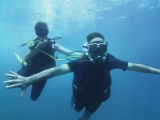Introduction
A ship or any other means of transport susceptible to shipwreck drags with it a whole series of objects, machines, documents and designs that inescapably correspond to that instant of sinking. This also happens with those isolated objects that fall into water and with places and spaces that, by human will or by chance, end up permanently flooded.
From the moment all this disappears beneath the surface, the remains become a "closed box" of memories of the past that remain almost intact in their original state.

Those who practice diving who are passionate about history are then offered a real physical space that belongs to the past and that returns after many years, with valuable information to be deciphered.
Must the remains be very old to have archaeological interest?
An archaeological object does not have to be an ancient object. Current legislation considers any historical remains as archaeological objects, regardless of their age.
What is a wreck?
A pecio is any means of transportation submerged under water , even if it is only a part of its structure or its own cargo. In this way, when we talk about a wreck, we have to understand that a cannon, the remains of a galleon, an old railway engine sunk in a reservoir, etc. are included in that definition.
In general, a wreck is a submerged remains. A submerged remains due to manipulation and with human origin that is found under water, and here we can include old flooded buildings, isolated objects or remains of port structures.

recreational diving in the surroundings of wrecks and other submerged remains can be practiced where the law allows it. In remains of historical interest, protection measures are more severe and access may be restricted. It is enough to remember that in many areas of Greece or Türkiye diving is prohibited. When, due to scientific, political or economic criteria, remains require study, the methodology used by terrestrial archeology, adapted to the aquatic environment, can be used.
Life does not only live on boats underwater archeology
The research field of underwater archeology is not limited to shipwrecks or their cargo. Its scope of action covers everything susceptible to study that is submerged underwater. Each case will have its specific technique. Logically, studying the remains of a Greek-era wreck 40 meters deep in the Mediterranean will not be the same as diving to investigate and excavate a Neolithic town covered by the shallow waters of an alpine lake.

What is underwater archeology?
"Doing underwater archeology" is not, as many believe, arbitrarily collecting as many pieces or pieces as appear in the water and storing them in museum warehouses. This is a concept totally out of date with reality.
Underwater archeology is another instrument for the study of history, which investigates the remains left by man under the waters. With this, information is obtained that serves to provide answers to the questions that history raises as a science.
An underwater archaeologist is like a detective. Through the scientific and contrasted interpretation of the distribution of the remains in a site, you can discover the direction that the vessel was following at the time of the shipwreck, the way in which the cargo was going. stowed on board, and even what was the cause of its sinking.

By going deeper into the investigation, you can find out the time of the shipwreck, what the crew's diet was, the ports of origin, stopovers and destination during the voyage and the causes that motivated the ship to undertake its last voyage, to name a few. examples. From now on, these data, sometimes apparently simple and unspectacular, can be contrasted with similar sites and with terrestrial investigations related chronologically or for another reason. Little by little the puzzle of history is being composed.
Hence the importance of not altering the original location of the objects we find underwater. It is very important that we are aware that an archaeological remains extracted from its original context loses all its informative value for archaeologists. Apart from breaking the law, we would be destroying data that may be essential during a future investigation process of the site.
A job for everyone
Underwater archeology requires the efforts of many professionals and amateurs. So important is the work of those who practice diving and those fishermen who communicate their findings as well as geologists and surveyors who make plans of the place.

Photographers and filmmakers, chemists, mechanics and sailors, among other specialists, are essential to guarantee the investigation process of a site until the end. A multidisciplinary team that serves to enrich our knowledge of man's use of seas and lakes for millennia in the past.
Can I put a bronze cannon in the living room?
It may be the dream of many divers, but... be careful with the law! All countries usually have specific legislation on their heritage and, specifically, submerged heritage. There are a series of international agreements by which many States have actively committed themselves to guaranteeing the protection of submerged cultural heritage, with a large number of purposes and laws in this regard.
In some countries, the investigation and possible recovery of submerged objects involves economic agreements between the State and individuals who invest in the project, such as, for example, in the United States. Other countries extremely limit access to places of historical interest, such as Greece. In many cases, commercial criteria predominate over scientific ones.

The worst thing that can happen to a recreational diver? That the country does not have a law in this regard. Then the applications and interpretations of the law can be so arbitrary that the result of a possible sanction is disproportionately severe in relation to the infraction imputed to the diver.
















